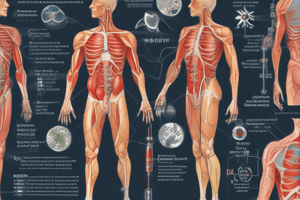Podcast
Questions and Answers
What is the primary acid-base imbalance indicated by the blood gas results?
What is the primary acid-base imbalance indicated by the blood gas results?
- Metabolic acidosis
- Respiratory alkalosis
- Respiratory acidosis
- Metabolic alkalosis (correct)
Which condition could lead to metabolic alkalosis due to excessive loss of hydrogen ions?
Which condition could lead to metabolic alkalosis due to excessive loss of hydrogen ions?
- Vomiting (correct)
- Excessive exercise
- Chronic bronchitis
- Severe diarrhea
What indicates that there is partial compensation in the patient's acid-base status?
What indicates that there is partial compensation in the patient's acid-base status?
- Abnormal PCo levels
- An expected fall in pH
- Normal pH levels
- High bicarbonate levels (correct)
What does a pH of 7.5 indicate in the context provided?
What does a pH of 7.5 indicate in the context provided?
What is a common symptom associated with metabolic alkalosis?
What is a common symptom associated with metabolic alkalosis?
What underlying condition is associated with increased reabsorption of bicarbonate leading to metabolic alkalosis?
What underlying condition is associated with increased reabsorption of bicarbonate leading to metabolic alkalosis?
What is a potential cause of respiratory alkalosis?
What is a potential cause of respiratory alkalosis?
Which of the following parameters indicates respiratory alkalosis in the provided case study?
Which of the following parameters indicates respiratory alkalosis in the provided case study?
What clinical symptom might a patient experience due to respiratory alkalosis?
What clinical symptom might a patient experience due to respiratory alkalosis?
In assessing compensation in acid-base disturbances, what should be evaluated?
In assessing compensation in acid-base disturbances, what should be evaluated?
What is the primary interpretation of the blood gas results presented?
What is the primary interpretation of the blood gas results presented?
Which of the following is NOT a cause of respiratory acidosis?
Which of the following is NOT a cause of respiratory acidosis?
What clinical symptoms may indicate respiratory acidosis in a patient?
What clinical symptoms may indicate respiratory acidosis in a patient?
What blood gas finding is indicative of hypoxia in the context of acid-base disturbances?
What blood gas finding is indicative of hypoxia in the context of acid-base disturbances?
Which condition among the following should be considered a likely underlying issue for respiratory acidosis?
Which condition among the following should be considered a likely underlying issue for respiratory acidosis?
What is the primary condition indicated by the blood gas results?
What is the primary condition indicated by the blood gas results?
Which of the following is NOT a cause of metabolic acidosis?
Which of the following is NOT a cause of metabolic acidosis?
What is the normal range of anion gap in the human body?
What is the normal range of anion gap in the human body?
Which clinical feature is associated with metabolic acidosis?
Which clinical feature is associated with metabolic acidosis?
How is the anion gap calculated?
How is the anion gap calculated?
What is the anion gap calculated from the patient's serum electrolytes?
What is the anion gap calculated from the patient's serum electrolytes?
What physiological effect can metabolic acidosis have on cardiac function?
What physiological effect can metabolic acidosis have on cardiac function?
In which of the following conditions is an increased anion gap likely observed?
In which of the following conditions is an increased anion gap likely observed?
What is the pH level associated with acidemia?
What is the pH level associated with acidemia?
Which condition is characterized by a pH level greater than 7.45?
Which condition is characterized by a pH level greater than 7.45?
What compensatory mechanism occurs in metabolic acidosis?
What compensatory mechanism occurs in metabolic acidosis?
How does the body respond to respiratory alkalosis in the short term?
How does the body respond to respiratory alkalosis in the short term?
What is the normal range for arterial blood gas pH?
What is the normal range for arterial blood gas pH?
Which of the following disorders is most likely associated with low HCO3 levels?
Which of the following disorders is most likely associated with low HCO3 levels?
What is the main driving force behind respiratory compensation in acidosis?
What is the main driving force behind respiratory compensation in acidosis?
What blood gas value indicates respiratory acidosis?
What blood gas value indicates respiratory acidosis?
In metabolic alkalosis, what compensatory mechanism is typically employed by the body?
In metabolic alkalosis, what compensatory mechanism is typically employed by the body?
Which primary type of acid-base disturbance occurs due to ventilatory issues?
Which primary type of acid-base disturbance occurs due to ventilatory issues?
What is the Pco2 normal range in arterial blood gas measurements?
What is the Pco2 normal range in arterial blood gas measurements?
In respiratory acidosis, how does the kidney compensate in the long term?
In respiratory acidosis, how does the kidney compensate in the long term?
What physiological process predominantly occurs during metabolic acidosis?
What physiological process predominantly occurs during metabolic acidosis?
Which condition is characterized by a decrease in HCO3 due to an acid-base imbalance?
Which condition is characterized by a decrease in HCO3 due to an acid-base imbalance?
Flashcards are hidden until you start studying
Study Notes
Acid-Base Disturbance
- Acid-base disturbances are imbalances in the body's pH levels.
- Normal pH levels are between 7.35 and 7.45.
- Acidemia is when the blood pH is below 7.35.
- Alkalemia is when the blood pH is above 7.45.
- The formula for calculating hydrogen ion concentration ([H]) is: [H] = 24 * Pco2 / [Hco3].
- Acidemia is associated with an increase in hydrogen ion concentration ([H]), partial pressure of carbon dioxide (Pco2), and bicarbonate (Hco3).
- Alkalemia is associated with a decrease in hydrogen ion concentration ([H]), partial pressure of carbon dioxide (Pco2), and bicarbonate (Hco3).
Types of Acid-Base Disturbances
- There are two main types of acid-base disturbances: respiratory and metabolic.
Respiratory Acid-Base Disturbances
- Respiratory acidosis is when the body cannot effectively get rid of carbon dioxide (CO2).
- This leads to an increase in Pco2.
- Respiratory alkalosis is when the body gets rid of too much CO2.
- This leads to a decrease in Pco2.
Metabolic Acid-Base Disturbances
- Metabolic acidosis is when the body has a build-up of acids other than CO2.
- This leads to a decrease in bicarbonate (HCO3-).
- Metabolic alkalosis is when the body has a loss of acid or an increase in the amount of bicarbonate.
- This leads to an increase in HCO3-.
Compensation Mechanisms
- The body has compensation mechanisms to help maintain normal pH levels.
- Respiratory compensation involves changes in breathing rate and depth to alter Pco2.
- Metabolic compensation involves the kidneys adjusting HCO3- levels.
Respiratory Compensation for Metabolic Disorders
- Metabolic acidosis leads to increased breathing rate (hyperventilation) to reduce Pco2 levels. This is known as Kussmaul breathing.
- Metabolic alkalosis leads to decreased breathing rate (hypoventilation) to increase Pco2 levels.
Metabolic Compensation for Respiratory Disorders
- Respiratory acidosis leads to increased HCO3- levels through buffering systems, primarily hemoglobin.
- Renal excretion of hydrogen ions also helps increase HCO3-.
- Respiratory alkalosis is compensated by the kidneys lowering hydrogen ion secretion in the initial 10 minutes.
- In the following 2-6 hours, the kidneys will further compensate by lowering hydrogen ion secretion.
Interpretation of Arterial Blood Gas (ABG) Results
- The first step in interpreting ABG results is assessing the pH level.
- Next, examine bicarbonate and carbon dioxide levels to determine their ranges (normal or abnormal).
- Evaluate if appropriate compensation is occurring by the body.
- Finally, determine if the disturbance is alkalosis or acidosis.
Case Studies
Case 1
- Newborn with respiratory distress
- ABG results:
- pH: 7.5 (high)
- Pco2: 20 mmHg (low)
- HCO3: 18 mEq/L (low)
- Interpretation: Non-compensated respiratory alkalosis
Case 2
- Child with repeated vomiting
- ABG results:
- pH: 7.49 (high)
- Pco2: 45 mmHg (high)
- HCO3: 35 mEq/L (high)
- Interpretation: Partially compensated metabolic alkalosis
Case 3
- Man with bronchial asthma
- ABG results:
- pH: 7.35 (normal)
- Pco2: 65 mmHg (high)
- HCO3: 28 mEq/L (normal)
- Interpretation: Fully compensated respiratory acidosis
Case 4
- Newborn with poor feeding and lethargy
- ABG results:
- pH: 7.2 (low)
- Pco2: 20 mmHg (low)
- HCO3: 15 mEq/L (low)
- Interpretation: Partially compensated metabolic acidosis
Anion Gap
- Anion gap is a calculation that helps differentiate between metabolic acidosis with an increased anion gap and metabolic acidosis with a normal anion gap.
- The formula for anion gap is: Anion gap = Na - (HCO3 + Cl)
- A normal anion gap is 12 +/- 4.
- An increased anion gap is often associated with metabolic acidosis.
Examples of Increased Anion Gap Metabolic Acidosis
- Renal failure
- Diabetic ketoacidosis
- Lactic acidosis
- Organic acidemia
Studying That Suits You
Use AI to generate personalized quizzes and flashcards to suit your learning preferences.





